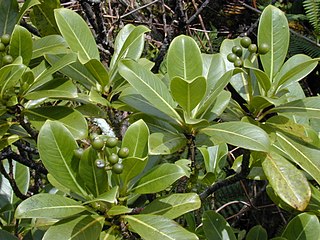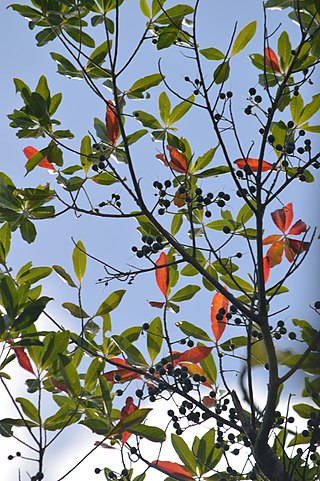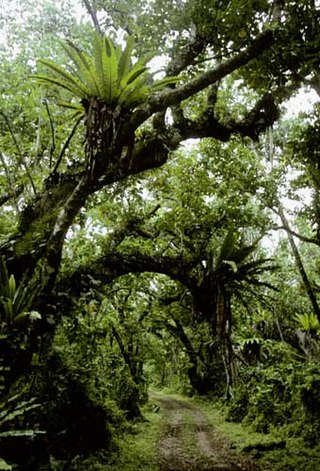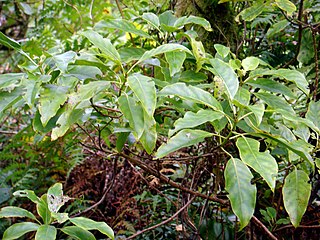
Rarotonga is the largest and most populous of the Cook Islands. The island is volcanic, with an area of 67.39 km2 (26.02 sq mi), and is home to almost 75% of the country's population, with 13,007 of a total population of 17,434. The Cook Islands' Parliament buildings and international airport are on Rarotonga. Rarotonga is a very popular tourist destination with many resorts, hotels and motels. The chief town, Avarua, on the north coast, is the capital of the Cook Islands.
Cook Islands Māori is an Eastern Polynesian language that is the official language of the Cook Islands. Cook Islands Māori is closely related to New Zealand Māori, but is a distinct language in its own right. Cook Islands Māori is simply called Māori when there is no need to disambiguate it from New Zealand Māori, but it is also known as Māori Kūki ʻĀirani or controversially Rarotongan. Many Cook Islanders also call it Te reo Ipukarea, literally "the language of the Ancestral Homeland".

The Rarotonga monarch, also known as the Rarotonga flycatcher or kakerori, is a species of bird in the monarch flycatcher family Monarchidae. It is endemic to the Cook Islands.
Psychotria adamsonii is a species of plant in the family Rubiaceae. It is a shrub or tree endemic to the island of Ua Pou in the Marquesas Islands of French Polynesia. It is thought to be extinct.
Psychotria atricaulis is a species of plant in the family Rubiaceae. It is endemic to the island of Huahine in the Society Islands of French Polynesia.
Psychotria cookei is a species of plant in the family Rubiaceae. It is a shrub endemic to the island of Raiatea in the Society Islands of French Polynesia.
Psychotria franchetiana is a species of plant in the family Rubiaceae. It is endemic to the island of Tahiti in the Society Islands of French Polynesia.
Psychotria grantii is a species of plant in the family Rubiaceae. It is a shrub or tree endemic to the island of Tahiti in the Society Islands of French Polynesia.
Psychotria raivavaensis is a species of plant in the family Rubiaceae. It is a shrub endemic to the island of Raivavae in the Tubuai Islands of French Polynesia.
Psychotria speciosa is a species of plant in the family Rubiaceae. It is a shrub or tree endemic to the island of Tahiti in the Society Islands of French Polynesia.
Psychotria tahitensis is a species of plant in the family Rubiaceae. It is endemic to the island of Tahiti, in the Society Islands of French Polynesia.
Psychotria trichocalyx is a species of plant in the family Rubiaceae. It is endemic to Tahiti, one of the Society Islands.

Psychotria mariniana, the forest wild coffee or kōpiko, is a tree endemic to Hawaiʻi. The plant belongs to the Rubiaceae (coffee) family, subfamily Rubioidae. It is a tree of varying size with a dark bark, shiny leaves, and orange oval fruit.
Lepturopetium is a genus of Pacific Island plants in the grass family.

Elaeocarpus joga is a species of tree in the family Elaeocarpaceae. It is native to the Mariana Islands and Palau. It is a moderately-sized tree with blue-coloured, round, 1.5cm diameter fruit and leaves which turn bright red before they senescence.

Geniostoma sykesii is a species of flowering plant in the family Loganiaceae, endemic to the islands of Mangaia and Mitiaro in the Cook Islands. It grows on makatea terrain. Its dried leaves are used in ‘ei, and used to scent multiple products.

Homalium acuminatum, the Cook Islands homalium, is a species of tree in the willow family, Salicaceae. It is endemic to the Cook Islands, growing on the islands of Rarotonga, where it is known as mato, and Mangaia, where it is known as moto. It grows to a height of up to 20 m (66 ft). On Rarotonga it dominates steep mountain slopes. The IUCN Red List calls it the Rarotonga homalium and considers it endemic to Rarotonga, though the Cook Islands Biodiversity Database lists it as also present, but "uncommon" on Mangaia.

The Cook Islands tropical moist forests is a tropical and subtropical moist broadleaf forests ecoregion that covers the Southern Cook Islands in the Cook Islands.

Coprosma laevigata, the Rarotongan coprosma, is a herbaceous plant, a member of the Rubiaceae family.

Callicarpa lamii is a plant in the mint family that is endemic to the Mariana Islands. It is one of two Callicarpa plants endemic to the Mariana Islands, the other being Callicarpa candicans var. paucinervia.









